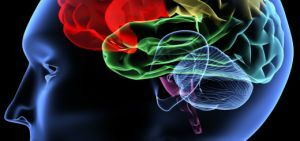 Brain atrophy - process of phased death of brain cells , destruction of neuronal and nerve cell connections. There may be abnormalities in the cortex or in the subcortex of the human brain.
Brain atrophy - process of phased death of brain cells , destruction of neuronal and nerve cell connections. There may be abnormalities in the cortex or in the subcortex of the human brain.
Often, the atrophy of the cerebral cortex occurs in old age, and most of the diagnosis is set to the weak sex.
Violation can occur in fifty - fifty five years, and end with dementia.
This is due to the fact that the aging and volume of the brain becomes less.
It should be noted that this deviation is characteristic for the frontal lobes, which control the executive functions. These functions include control, planning, inhibition of behavior, thoughts.
Content
- Causes
- Types atrophy
- degree of atrophy
- Symptoms of brain atrophy
- Therapy for brain atrophy
- Preventive measures
- Video: The brain and its functions
reasons
disease One of the main causes of brain atrophy is a genetic predisposition to the disease. But the violation can also appear for other reasons:
- The poisoning effect of alcohol , some narcotic drugs and medicines. In this case, both the cortex and the subcortical structures of the brain can be affected.
- Injuries , including those obtained during neurosurgical intervention. The damaging effect on the brain tissue appears when the vessels are squashed and ischemic manifestations are manifested. In addition, similar can appear and in the presence of benign formations, clamping blood pathways.
- Ischemic manifestations of may also occur due to significant vascular damage by atherosclerotic plaques, which is common in older people, which causes a deterioration in nerve tissue nutrition and its death.
- Chronic anemia with a significant decrease in the number of erythrocytes in the blood or hemoglobin in them. This deviation causes a decrease in the ability of the blood to attach oxygen molecules and communicate them to the tissues of the body, and to the nervous ones too. Ischemia and atrophy appear.
However, there is a list of conditions that favor such a violation:
- low mental loads;
- excessive smoking;
- hydrocephalus;
- chronic low blood pressure;
- long reception of substances narrowing the blood vessels.
Types of atrophy
Consider what types of brain atrophy are:
- Cortical brain atrophy - the process of death of the brain cortex tissues, associated with age-related changes in the structure of the nervous tissue or with general
 disorders occurring in the body of the patient. Frontal lobes are most often damaged, but it is possible that other parts of the process can also be connected to the process.
disorders occurring in the body of the patient. Frontal lobes are most often damaged, but it is possible that other parts of the process can also be connected to the process. - Multisystem brain atrophy is an increasing neurodegenerative disease with damage to the basal ganglia, cerebral trunk, cerebellum, spinal cord, expressed by parkinsonism, cerebellar ataxia, vegetative insufficiency and pyramidal syndrome in different ratios.
- Diffuse brain atrophy-appears in many processes of different origin, the flow is very variable. Initially, the disease occurs as a disorder of the cerebellum, and only later there are special signs that make it possible to identify the primary pathological process.
- Atrophy of the cerebellum of the brain - the growth of cerebellar disorders in combination with manifestations of damage to other parts of the nervous system.
- Back cortical - deposits in the form of plaques and neurofibrillar plexuses causing the death of nerve cells in the parieto-occipital parts of the brain.
 Fracture of the base of the skull can also cause brain atrophy and other most severe consequences. What is neurinoma of the auditory nerve - treatment, symptoms and signs, diagnosis of the disease and other necessary information about the pathological condition.
Fracture of the base of the skull can also cause brain atrophy and other most severe consequences. What is neurinoma of the auditory nerve - treatment, symptoms and signs, diagnosis of the disease and other necessary information about the pathological condition.
Degrees of atrophy
The development of the deviation occurs according to the scheme:
- The initial stage of or brain atrophy of the 1st degree - there are no clinical signs, but a rapid development of the disorder and its transition to the next stage of the disease.
- The second stage of the is a rapid deterioration in the patient's communication with others. At the same time, a person becomes conflicted, can not normally take criticism, catch a thread of conversation.
- The third stage of - the patient gradually loses control over the behavior. There may be unreasonable outbursts of anger or despondency, behavior becomes outrageous.
- The fourth stage of is the loss of awareness of the essence of events, the demands of others.
- Final stage - The patient does not understand the events that occur, and they do not evoke any emotion in him.
Depending on the affected areas of the frontal lobe, speech disorders, lethargy, indifference or euphoria, sexual hyperactivity, and certain types of mania may appear at the earliest.
The last moment often makes the patient dangerous for the community that is an indication for his placement in a psychiatric hospital.
If there is a violation of the blood supply to the brain, one of the diagnostic signs may be the death of the temporal muscle, which is observed in some patients.
Symptoms of cerebral atrophy
The existing symptoms of lesion may have significant differences, depending on which parts of the organ are destroyed. At atrophy of the bark , the following are observed:
- decreased ability to think and analyze;
- change in tempo, tone and other features of speech;
- memory degradation to an absolute inability to remember anything;
- violation of the mechanics of the fingers;
- affection of the subcortical parts leads to the appearance of more serious symptoms.
Their peculiarity depends on the purpose of the broken part:
- atrophy of the medulla oblongata - violation of respiration, cardiovascular activity, digestion, protective reflexes;
- cerebellar lesion - violation of muscle tone of the skeleton and coordination of a person;
- the death of the middle brain - the disappearance of the reaction to external stimuli;
- atrophy of the intermediate brain - loss of ability to thermoregulation, homeostasis, a malfunction in the balance of the metabolic processes;
- atrophy of the forebrain - loss of all kinds of reflexes.
 Substantial affection of subcortical structures often causes the loss of patients' ability to independently maintain vital activity, hospitalization and death in the future.
Substantial affection of subcortical structures often causes the loss of patients' ability to independently maintain vital activity, hospitalization and death in the future.
This degree of atrophy occurs very rarely, often after severe injuries or poisonous damage to brain tissue and large blood vessels.
Therapy for Brain Atrophy
When treating brain atrophy, it is important for a person to ensure good care, as well as increased attention from relatives. To alleviate the symptoms of cerebral catarrh atrophy, only the treatment of manifestations is prescribed.
If you find the first signs of atrophy processes, you should create a calm situation for the patient .
He should not change the standard way of life. The best is the execution of ordinary domestic affairs, support and care from relatives.
Other methods of treatment of include:
- application of sedative;
- use of light tranquilizers;
- taking antidepressants.
These tools help a person to remain calm. The patient must necessarily create all the conditions for active movement, he must regularly engage in simple daily affairs.
Among other things, it does not follow that a person who has such a violation slept during the day.
Preventive measures
There are no effective ways to prevent this disease today. You can advise only in time to treat all existing violations, lead an active life and have a positive attitude.
Life-loving people often live to a very old age, and they show no signs of atrophy.
There are people who develop atherosclerosis much faster, which is the cause of early deterioration of the body. It is they who observe the bright processes of atrophy.
Ways of preventing atherosclerosis:
- a healthy lifestyle;

- proper nutrition;
- high motor activity;
- quitting;
- refusal of alcohol;
- blood pressure level monitoring;
- consumption of fresh fruits and vegetables;
- replacing animal fats with vegetable;
- unloading days;
- is an everyday memory training.
Brain atrophy is a disease that is not treated with modern medicines. This disorder does not develop immediately, but in the end it ends with dementia.
To prevent negative consequences, the must be adhered to prophylactically. Among other things, if you have any problems, it is very important to contact the doctor in time - this will help to save good health for many years.
Video: The brain and its functions
The structure and functions of the brain. How the brain reacts to external stimuli and what you need to know about possible brain damage.



